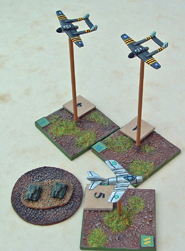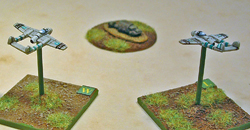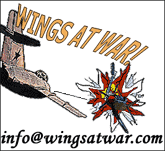Suez 1956
![]()
Two Western powers form a coalition to attack a Middle Eastern country they consider of vital strategic importance, their main aim being to topple a leader they believe is supporting terrorist groups. They use what some may consider a dubious justification for their invasion, and are taken aback by the strength of opposition at home and the almost universal approbation from the rest of the World. Sounds familiar? Well this was back in 1956.
What is sometimes euphemistically called the Suez Crisis was to all intense and purposes a war. Four years earlier the King of Egypt had been ousted in a coup by the Arab nationalist Colonel Nasser, who then nationalised the Anglo-French Suez Canal Company.
Nasser's intentions were made clear when he created a powerful air force, including a core of modern Soviet designed jets organised into three squadrons each of MiG-15s, Il-28s, Vampires and Meteors, a small squadron of the new MiG-17 plus a training squadron of two-seat MiG-15s; nearly 200 jets in all. A number of piston-engine planes had already been de-activated or relegated to training duties but many of these were to see action in the ground attack role.
Israel Attacks
Britain and France engaged the willing
services of Israel, still struggling to cement her existence surrounded
by hostile countries and suffering from the blockade
of her only Red Sea port, to engineer a pretext for an attack. On
the 29th of October the Israelis launched a
 parachute raid on the Mitla
Pass deep in Egyptian territory and just to the east of the Suez Canal,
ostensibly in retaliation for Palestinian guerrilla attacks. This
was soon followed to the north by an armoured thrust across the
border into Sinai. To allow the Israeli Air Force to concentrate
on offensive duties, French Mystere IVs and F-84s were dressed up
in Israeli markings, given made-up unit numbers and sent to Israel
to defend against bomber attacks on Israeli cities.
parachute raid on the Mitla
Pass deep in Egyptian territory and just to the east of the Suez Canal,
ostensibly in retaliation for Palestinian guerrilla attacks. This
was soon followed to the north by an armoured thrust across the
border into Sinai. To allow the Israeli Air Force to concentrate
on offensive duties, French Mystere IVs and F-84s were dressed up
in Israeli markings, given made-up unit numbers and sent to Israel
to defend against bomber attacks on Israeli cities.
Egyptian and Israeli jets were soon operating over the battlefield and it wasn't long before the first combats took place. In one encounter six Israeli Mysteres on a standing patrol over the Mitla Pass were held off by six MiGs whilst a brace of Egyptian Meteors broke through and bombed the paras. Israeli ground units were taking heavy losses from the increasing tempo of Egyptian air attacks but Israeli bombing runs scored heavily too. Both sides were forced to dig-in at opposite ends of the pass. In one brief tussle two Israeli Mysteres bounced four Egyptian Vampires shooting them all down. Seven Egyptian planes were lost to Israeli fighters on the Sinai front.
The Israelis then sent in their piston-engine aircraft but the these suffered heavily at the hands of enemy anti-aircraft fire. Five Mustangs and two Harvard trainers were lost. That evening Il-28s attacked Israeli airfields.
The Three Musketeers
Britain and France then issued an ultimatum, one they knew could not be accepted; both Egypt and Israel were to withdraw from the Suez Canal Zone in order to ensure the safety of international shipping. When the ultimatum expired, and not withstanding the fact that the Israelis were not even in the Canal Zone, Britain and France initiated Operation Musketeer/Mousquetaire.
Like the Egyptians, the French and British had almost completed the transition from piston planes to jets. The British operated exclusively British designed machines. Some dated from WW2 but were at least reliable and sturdy, though inferior in terms of performance to the Egyptian MiGs. The newly introduced Hunter, able to match the latest MiG, was generally reserved for the air-superiority role. The French and Israelis both flew a mixture of French and American jets of varying vintage but they also used a hodgepodge of piston planes they'd manage to beg steal or borrow from various sources. Israeli pilots were well trained and aggressive but not as experienced in operating jets.
The overcrowded airfields of Cyprus and fleet of transport ships were a tempting targets for Egypt's jet bombers. With a force of over 500 aircraft, the Anglo-French strategy was to eliminate this threat by bombing the enemy runways and then hit the grounded Egyptian planes with fighter-bomber raids launched from land bases and aircraft carriers. With the enemy air arm neutralised, the ground troops would go in to secure Egypt's Mediterranean ports and the Canal itself.
Fifteen RAF squadrons of Canberra and Valiant bombers based in Cyprus and Malta initiated the offensive. The results of these first bombing missions were disappointing; accuracy varied widely but average errors were 1,000 yards for the Valiant and 700 yards for the Canberra, though with around three times the load the Valiant spread its bombs over a wider area. In order to preserve their main strike force the Egyptians withdrew their Il-28 jet bombers to Luxor in the south. These were later singled out by French F-84Fs fitted with long-range fuel tanks and most were destroyed on the ground.
During the next few days British and French fighter-bombers from Cyprus, and aircraft operating from the aircraft carriers HMS Albion, Bulwark and Eagle, and the French Arromanches and Lafayette, systematically attacked every Egyptian airfield and succeeding in destroying around 40% of the Egyptian Air Force whilst it was still on the ground. Any left undamaged found it difficult to take off without being immediately pounced on by enemy fighters. Other targets included rail yards, coastal artillery, radar sites, barracks and the Cairo Radio building.
Demand for air support on the Sinai
front meant that the Israeli-based French planes were now thrown
into attacks against columns of Egyptian troops. French pilots claimed
no less than thirty eight T-34 tanks destroyed, though several aircraft
were damaged and two were written off following crash landings.
Israeli paratroopers were dropped near Sharm El Sheikh on the Red
Sea precipitating a fierce air battle in the skies above. The paras
held out until relieved by an Israeli thrust from the north.
landings.
Israeli paratroopers were dropped near Sharm El Sheikh on the Red
Sea precipitating a fierce air battle in the skies above. The paras
held out until relieved by an Israeli thrust from the north.
On the 5th November the British and French launched their ground attack with parachute and seaborne landings along the northern end of Suez followed by a thrust south down the length of the Canal. The Egyptians switched their emphasis to combating the invasion, allowing the Israelis to increase the pressure in the east and they overran all of Sinai except for the strip adjacent to the Canal. The Egyptian effort against the British and French soon petered out and Allied fighters were diverted to ground support.
Cease Fire
Egyptian pilots had stood up well to the initial attack, they had already fought Israeli planes on many occasions since the instigation of the State of Israel in 1948. During the early days morale soared following considerable success in attacking Israeli ground troops but once the massive fleet of British and French aircraft, many of the crew veterans of WW2, had joined in, the Egyptian Air Force was overwhelmed and all but destroyed. As the attackers, the Allies not only held the initiative but also had a properly structured plan. Effective use of reconnaissance also meant that they were able to react to changing events far more quickly. Egyptian high command was at best indecisive mainly due to being hamstrung by political control.
Though the Allies were militarily successful Soviet and in particular US pressure, a presidential election was weeks away, threatened to precipitate an economic crisis forceing Britain and France to agree to a cease fire not much more than a week after the start of hostilities. Ironically the big winners were Egypt and Israel; Egypt by its vastly increased prestige, support from the Soviet Union and de facto leadership of the Arab world, and Israel by the demilitarisation of Sinai and consequent lifting of the blockade of the Red Sea port of Eliat.
An interesting footnote to this story is the existence of Operation Cordage, the Anglo-French plan to attack their erstwhile ally if Israel widened the scope of its offensive by attacking either Jordan or Iraq. Britain in particular still wanted to retain good relations with the Arab world, and even during the campaign open conflict nearly broke out when Israeli planes mistakenly attacked a British destroyer. In addition, following fierce political and public disapproval of the Anglo-French operation, American carrier planes and ships carried out cat-and-mouse interference missions throughout the campaign. British fighters were scrambled on numerous occasions to intercept these 'bogies' and this could easily have resulted in accidental (or otherwise) clashes.
Suez proved to be the swan song of the gun-only fighter and not long after Chinese Nationalist F-86Fs used the first Sidewinder heat seeking missiles to shoot down 24 Communist Chinese MiGs. One unexploded missile brought home in the jetpipe of a MiG-15 provided the means for the Soviets to produce a direct copy. The missile age had arrived.

French Mystere IV
Click on the links below for more information
